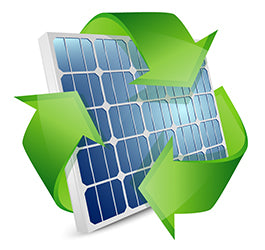
Here's a common question about solar energy: Are solar panels recyclable? Actually, they are! While there is still a need for much more comprehensive recycling of solar panels, a good portion of them are made from recyclable materials and are suitable for an eco-friendly way of discarding.
The recyclable materials that makeup panels are typically broken down in the process by a licensed solar recycling power plant, which can cost you around $10 to $20 per panel excluding freight or removal fees.
Why do you need to recycle, anyway? Well as with other types of waste, this largely helps the environment. It's estimated that 100,000 to 150,000 solar panels are replaced annually which results in over 900 thousand tons of solar panel waste by 2050 in Australia alone. Unless there is a constant effort to recycle, the valuable resources that can be reused to make new solar panels will end up in landfill instead.
Luckily, there are several types of panels that can be recycled including the famous monocrystalline solar panels, polycrystalline solar panels, and thin-film solar cells. Up to 95% of a panel can also be recycled with the most valuable parts being the glass, aluminium frames, silicon, and copper.
This means that if you have glassed fixed solar panels, flexible solar panels, or any of the standard types, you can have them recycled at the end of their life with no problems.
How Are Solar Panels Recycled?
Take a sneak peek into what happens to your solar panels after they are delivered to dedicated recycling facilities.
Stage 1: Breaking Down
Your panels will be shredded into tiny pieces to expose all the different components. This way, it's easier for the recycler to determine and separate them for the second stage.
Stage 2: Separation Process
Typically, solar panel recycling facilities have various detectors to effectively segregate the materials such as glass, copper wiring, steel, plastics, aluminium, cables, and more.
Each of these detectors operates in a different waysome use colours or pattern sensors while others use magnetic eddy currents or more advanced technologies for detecting specific materials.
Important: The separation of materials is a crucial stage and can only be successful if the first stage is done accurately.
Stage 3: Reuse of Materials
Once the commodities are separated, they are returned to the industry for the manufacture of new items.
How About Solar Battery Recycling?
If you have paired your panels with a solar battery storage, there are tons of waste management centres and designated recycling plants for it as well. Batteries should be handled just as carefully as solar panels as they contain lithium-ion, which can have detrimental effects to the environment.
Currently, the Commonwealth Scientific and Industrial Research Organisation (CSIRO) predicts that Australia will have around 100,000 tonnes of lithium-ion battery waste by 2036 if the percentage of battery users who recyclewhich is at 2%doesn't increase.
The Future of Solar Panel Recycling
At present, there are 6 main solar panel recycling plants across Australia. These include Reclaim PV, PV Industries, SolaCycle, CMA Ecocycle, and Ecoactiv. Usually, utilising these services will incur additional costs and depending on which one you're coordinating with, you may have to transport your old solar panels to them yourself.
There is also still a need for a streamlined process when it comes to recycling solar panels. On top of this, there is some hesitance on the part of users due to the costs. This is why other ways of discarding solar panels are made available, like coordinating with your installers to take care of them for you. Take note though, that may not take the recycling into their own hands!
If recycling isn't looking attractive at the moment, you can try giving your solar panels to a scrap dealer or selling them if they're still operating at some capacity. You can even modify panels that are still partially working and use them for short trips in your campervan!



